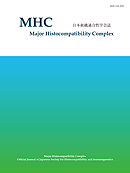
- Issue 3 Pages 109-
- Issue 2 Pages 55-
- Issue 1 Pages 1-
- |<
- <
- 1
- >
- >|
-
Fumiaki Nakajima, Yoshihide Ishikawa, Junko Nakamura, Toshio Okano, Ch ...1995Volume 2Issue 1 Pages 1-5
Published: 1995
Released on J-STAGE: March 31, 2017
JOURNAL FREE ACCESSWe have found a few alloantisera which react with a serologically undefined HLA-C blank specificity. At the 11th. International Histocompatibility Workshop, the tail reaction of an antiserum "BRA2O7" defined the identical specificity to our HLA-C blank specificity. We confirmed that this new specificity showed a cross reactivity with Cw8 antigen by means of an absorption test.Thus we tentatively named "Cw8N" as a potential split of HLA-Cw8. The antigen frequency was 13% in the Japanese population. Then, we analyzed the nucleotide sequence of Cw8N. As a result, the allele coding for Cw8N was identical to "Cw*0801". Furthermore, we examined association between Cw*0801 and HLA-B alleles. As for B61 alleles, B*4006 was strongly associated with Cw*0801, whereas B*4002 was associated with a different antigen Cw10. Also observed was an association between B*1502 and Cw*0801.
View full abstractDownload PDF (2778K) -
Atuko Ogawa, Ling Lin, Kouichi Kashiwase, Yosihisa Watanabe, Katsushi ...1995Volume 2Issue 1 Pages 6-9
Published: 1995
Released on J-STAGE: March 31, 2017
JOURNAL FREE ACCESSIt is known that HLA-B60/B61 heterozygotes often cannot be distinguished from HLA-B60/B60 homozygotes by serological analysis, because monospecific anti-HLA-B61 serum is seldom availahie. Moreover, it is sometimes difficult to discriminate B60/B48 or B61/B48 heterozygotes from B60 or B61 homozygotes by serology. In order to overcome these difficulties, we established a system for discriminating HLA-B60, B61, and B48 groups by means of polymerase chain reaction with sequence specific primers(PCR-SSP) using genomic DNA. By using this system, all the examined samples were easily judged for positivity of B60, B61 or B48 group.
View full abstractDownload PDF (2258K) -
Hisako Kawata, Taeko Naruse, Yoshisuke Nose, Asako Ando, Hidetoshi Ino ...1995Volume 2Issue 1 Pages 10-15
Published: 1995
Released on J-STAGE: March 31, 2017
JOURNAL FREE ACCESSNovel class II genes, DMA and DMB have been mapped recently between the DQ and DP genes within the HLA class II region. It has been suggested that DM molecule functions at an intracellular site to promote class II molecule-peptide association in the antigen presentation pathway. Genetic polymorphisms in the DMB gene are concentrated in the 3rd exon coding theβ2 domain and 4 alleles (DMB* 0101-0104) have been so far identified in Caucasian populations. In this study, we have analyzed genetic polymorphism in a Japanese population by direct automated sequencing and polymerase chain reaction-restriction fragment length polymorphism (PCR-RFLP) method and could recognize DMB* 0101 (48.0%) , DMB* 0102 (20.0%) , and DMB* 0103 (24.5%). No DMB* 0104 was detected. Further, a new allele (DMB* 595new) containing Val and lie at amino acid positions 50 and 85, respectively was identified in a B-lymphoblastoid cell line of Japanese origin. DMB* 0101 and DMB* 0102 were found to he in linkage disequilibria with DPB1* 0402 and DRB1* 1502, and with DRB1* 1101 and DRB1* 1405, respectively. HLA-DMB typing using the PCR-RFLP method estahlished in this study will he useful to analyze the BLA class II-disease association and also to perform the HLA matching for donor selection in unrelated transplantation.
View full abstractDownload PDF (3445K) -
Tatsunori Matsuzaki, Shosaku Nomura, Tomoko Ishida, Hideo Kagawa, Shir ...1995Volume 2Issue 1 Pages 16-18
Published: 1995
Released on J-STAGE: March 31, 2017
JOURNAL FREE ACCESSThe lymphocytes of 46 patients with the clinical diagnosis of immune thrombocytopenic purpura (ITP) were typed for HLA class I and II antigens. The B75 and antigens were present in an increased frequency, and the B61 and Cw3 antigens in a decreased frequency compared to controls. In HLA class II antigens, DRB1* 0410, DRB1* 1301, DQB1* 0302, DQB1* 0402, DPB1* 0202, DPB1* 0601, DPB1* 1001, and DPB1* 1901 were present in an increased frequency, and DRB1* 0405, DQB1* 0303, and DPB1* 0201 in a decreased frequency compared to controls. However, only two alleles (DRB1* 0410 and DQB1* 0302) were significant (p<0.05 X2 test), in particular, DRB1* 0410 was present in 10 of 46 patients, with a significantly increased frequency (p<0.05). Three of these 10 DRB1* 0410 patient were homozygous and the remaining 7 ones were heterozygous for DRB1* 0410. Furthermore, the heterozygous DQB1* 0402 allele was present in 5 of these 7 DRB1* 0410 heterozygous patients. These results suggest that there is an association between HLA class II alleles (DR4 and associated antigen) and some ITP patients.
View full abstractDownload PDF (1838K)
- |<
- <
- 1
- >
- >|